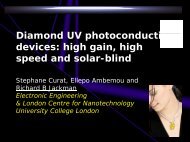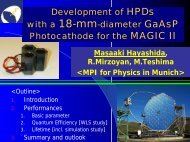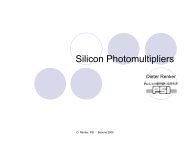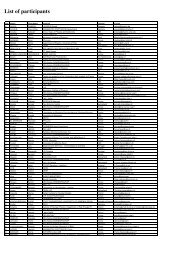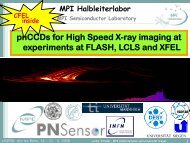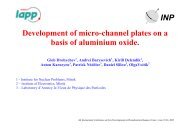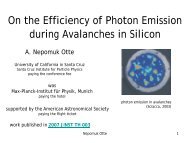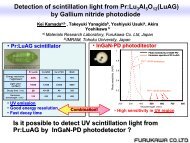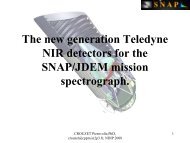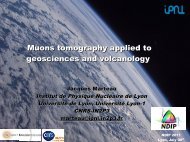BARBIER, Remi (University of Lyon 1 - IPNL) - NDIP 11 - IN2P3
BARBIER, Remi (University of Lyon 1 - IPNL) - NDIP 11 - IN2P3
BARBIER, Remi (University of Lyon 1 - IPNL) - NDIP 11 - IN2P3
You also want an ePaper? Increase the reach of your titles
YUMPU automatically turns print PDFs into web optimized ePapers that Google loves.
Rémi Barbier, <strong>NDIP</strong> 20<strong>11</strong>, <strong>Lyon</strong>, France, July 4-8<br />
TUTORIAL<br />
PHOTODETECTION<br />
Rémi <strong>BARBIER</strong><br />
<strong>University</strong> <strong>of</strong> <strong>Lyon</strong><br />
<strong>IPNL</strong> / <strong>IN2P3</strong> / CNRS<br />
www.ipnl.in2p3.fr/ebcmos<br />
1
Sources<br />
Sources: slides from …<br />
• Yuri MUSIENKO (Boston / INR RAS Moscow)<br />
• Katsushi ARISAKA (UCLA)<br />
• Philippe MANGEOT (CEA/DSM/DAPNIA)<br />
• Thierry GYS (CERN)<br />
• Alain BARDOUX (CNES)<br />
• P. DE MOOR (IMEC)<br />
• And many others ….<br />
On the Web<br />
• Hamamatsu, Photonis SA, Philips, SensL, Radiation Monitoring Devices,<br />
Photonique SA, Voxtel, Zecotek Photonics, Amplification technologies, STM, Id<br />
Quantique, Micro Photon Device, Intevac, Fairchild Imaging…<br />
What will not be discussed in this tutorial:<br />
• IR Imaging devices<br />
• Gaseous devices<br />
• X ray detectors<br />
• ….<br />
• Due to personal choice and time constraint<br />
Rémi Barbier, <strong>NDIP</strong> 20<strong>11</strong>, <strong>Lyon</strong>, France, July 4-8 tutorial : photodetectors<br />
2
Outlines<br />
Part I: The key parameters <strong>of</strong> the photon detection<br />
Part II: Photodetectors (basics & trends)<br />
• Vacuum devices:<br />
o Photomultiplier Tubes<br />
o MicroChannel Plate<br />
o Hybrid<br />
• Solid State devices:<br />
o PhotoDiode<br />
o Avalanche Photo Diode : APD<br />
o Geiger Mode APD : Arrays <strong>of</strong> SPAD: SiPM / MPPC …<br />
o Imaging devices: CCD and sCMOS, EMCCD<br />
Rémi Barbier, <strong>NDIP</strong> 20<strong>11</strong>, <strong>Lyon</strong>, France, July 4-8 tutorial : photodetectors<br />
3
Part I<br />
Part one : key parameters<br />
Photometric units<br />
Photoelectric effect<br />
The steps <strong>of</strong> the photon detection<br />
Quantum Efficiency and Photon Detection Efficiency<br />
Energy Resolution: Excess Noise Factor, Equivalent Noise Charge<br />
Spatial resolution & Pixels<br />
Temporal resolution<br />
Rémi Barbier, <strong>NDIP</strong> 20<strong>11</strong>, <strong>Lyon</strong>, France, July 4-8 tutorial : photodetectors<br />
4
Introduction: The steps <strong>of</strong> the Photon Detection<br />
The 4 steps <strong>of</strong> the photo-detection process:<br />
1. The primary charge carrier (pe, e/h) is produced<br />
2. The primary charge carrier is collected<br />
3. The primary charge carrier is multiplied/amplified or not (CMOS/CCD/PD)<br />
4. The secondary (or primary) charges are collected and read out<br />
The measurement process is modified by noise sources and by signal<br />
collection inefficiency at each step:<br />
Rémi Barbier, <strong>NDIP</strong> 20<strong>11</strong>, <strong>Lyon</strong>, France, July 4-8 tutorial : photodetectors<br />
6
Introduction – Photoelectric effect<br />
The photoelectric effect is responsible for the photon detection.<br />
We can distinguish two types:<br />
1. External: the phe is emitted into the vacuum from a photocathode material.<br />
2. Internal: the phe is excited and occupies the conduction band <strong>of</strong> the<br />
semiconductor material, the photoconductive effect.<br />
material<br />
External<br />
Vacuum<br />
Two types <strong>of</strong> photon detection<br />
pe escapes the material Notation in what follows:<br />
• ph = photon<br />
• pe = photoelectron<br />
• e/h = electron/hole<br />
pe in the Cond. band<br />
Rémi Barbier, <strong>NDIP</strong> 20<strong>11</strong>, <strong>Lyon</strong>, France, July 4-8 tutorial : photodetectors<br />
<br />
Cond. Band<br />
7
€<br />
Part I: key parameters – photon detection<br />
Light absorption: depends on λ<br />
20 µm<br />
2 µm<br />
100 nm<br />
Intrinsic silicon 300°K<br />
0.4<br />
Quantum efficiency:<br />
QE(%) = N pe<br />
N γ<br />
0.6<br />
I. DJITE PhD ISAE 20<strong>11</strong><br />
×100<br />
Silicon is at least two times better than Photocathode !!<br />
0.8<br />
… But … it is only the beginning <strong>of</strong> the story …<br />
€<br />
λ (µm)<br />
input light<br />
λ = 350 nm λ = 550 nm<br />
Charge carrier concentration vs lambda<br />
λ = 632 nm λ = 800 nm<br />
I. DJITE PhD ISAE 20<strong>11</strong><br />
Rémi Barbier, <strong>NDIP</strong> 20<strong>11</strong>, <strong>Lyon</strong>, France, July 4-8 tutorial : photodetectors<br />
Attenuation Length L opt<br />
10 µm<br />
10 µm<br />
φ(z) = φ0 exp( −α(λ).z)<br />
10 µm<br />
10 µm<br />
8
Part I: key parameters – Photon Detection – QE – FF – PDE – DQE …<br />
Be careful ! each photodetector type has his proper definition <strong>of</strong> QE and PDE…<br />
Example: QE for CCD is QExFF …<br />
Definitions:<br />
1. The radiant sensitivity (S) [A/W]: is the ratio between the output current from PC and the<br />
input radiant power at a given wavelength. S is related to QE by:<br />
S(mA /W )<br />
QE(%) ~ 124 ×<br />
λ(nm)<br />
2. The Fill Factor (FF) is the ratio between the sensitive surface and the detector surface also<br />
called geometrical efficiency (ε geom).<br />
€<br />
3. Collection Efficiency (CE) is the probability to transfer the primary pe or e/h to the<br />
amplification stage or readout channel.<br />
4. Multiplication Efficiency (ME) is the prob. that the amplification process give a detectable<br />
signal or trigger a multiplication (ε Geiger).<br />
5. Photon Detection Efficiency (PDE) is the probability that a single photon trigger a detectable<br />
output pulse also called the Detective Quantum Efficiency (DQE).<br />
DQE = PDE = (FF) . (QE) . (TE) . (ME)<br />
phodiode<br />
FF ~ 40%<br />
PDE = QE . ε geom . ε geiger (SiPM)<br />
Rémi Barbier, <strong>NDIP</strong> 20<strong>11</strong>, <strong>Lyon</strong>, France, July 4-8 tutorial : photodetectors<br />
pixel<br />
9
€<br />
Part I: key parameters – Energy resolution and ENF<br />
• Energy = Number <strong>of</strong> collected secondary carriers<br />
E = M × PDE × N γ<br />
• Energy Resolution with Readout Noise<br />
1<br />
SNR<br />
= σ<br />
E =<br />
ENF<br />
PDE × N γ<br />
⎛⎛ ENC ⎞⎞<br />
+ ⎜⎜<br />
⎟⎟<br />
⎝⎝ M × PDE × Nγ ⎠⎠<br />
Excess Noise Factor for single pe: ENF 1pe also noted F or sometimes F 2<br />
ENF1pe =1+ σ 2<br />
M<br />
M 2<br />
Excess Noise Factor for N pe input carriers: ENF Npe<br />
Experimentalist definition<br />
ENFN = pe σn out<br />
2<br />
σnin Multiplication Noise Readout Noise<br />
2<br />
€<br />
Rémi Barbier, <strong>NDIP</strong> 20<strong>11</strong>, <strong>Lyon</strong>, France, July 4-8 tutorial : photodetectors<br />
€<br />
n in<br />
∑<br />
n out = m i<br />
€<br />
2<br />
n out = m n in<br />
i=1<br />
2 2 2 2<br />
σ = m σnin + nin σ nout<br />
m<br />
Burgess’s theorem<br />
• M is the Mean Multiplication coefficient<br />
M is a stochastic variable with variance σ Μ 2<br />
• ENF is the excess noise factor. ENF is<br />
the noise due to the multiplication process<br />
• ENC : Equivalent Noise Charge<br />
(readout noise from the electronics)<br />
• PDE is the Photon Detection Efficiency<br />
Many different definitions in the literature<br />
ENFN = M pe 2 1+ n ⎡⎡<br />
in<br />
⎢⎢ 2<br />
⎣⎣ ⎢⎢ σnin ENF N pe = M 2 ENF 1pe<br />
⎤⎤<br />
( ENF1pe −1)<br />
⎥⎥<br />
⎦⎦ ⎥⎥<br />
If n in Poisson<br />
10
Part I: key parameters - energy resolution<br />
Summary:<br />
K. Arisaka, NIM A 442 (2000) 80<br />
€<br />
Slide from K. Arisaka Lecture UCLA<br />
€<br />
1<br />
SNR<br />
1<br />
SNR<br />
= σ<br />
E =<br />
= σ<br />
E =<br />
ENF<br />
PDE × N γ<br />
⎛⎛ ENC ⎞⎞<br />
+ ⎜⎜<br />
⎟⎟<br />
⎝⎝ M × PDE × Nγ ⎠⎠<br />
Rémi Barbier, <strong>NDIP</strong> 20<strong>11</strong>, <strong>Lyon</strong>, France, July 4-8 tutorial : photodetectors<br />
1<br />
N γ<br />
Ideal case: shot noise<br />
2<br />
<strong>11</strong>
€<br />
Part I: key parameters – energy resolution – figure <strong>of</strong> merit<br />
σ<br />
E N ph<br />
Rémi Barbier, <strong>NDIP</strong> 20<strong>11</strong>, <strong>Lyon</strong>, France, July 4-8 tutorial : photodetectors<br />
12
€<br />
Part I: T. Hollenhorst, A theory <strong>of</strong> multiplication Noise, IEEE Transactions on electron devices Vol. 37. N0. 3. MARCH 1990<br />
• Two stages gain: definitions and notations.<br />
h<br />
• mij multiplication gain from i to j is described by a probability distribution function (pdf) Pij(mij) with ij=01,10,12,21<br />
• mij-1 secondary carrier multiplication gain from i to j related to primary carrier gain mij • Φ ij the generating function <strong>of</strong> the pdf <strong>of</strong> m ij<br />
• Ψ ij the generating function <strong>of</strong> the pdf <strong>of</strong> m ij -1<br />
Ι<br />
e e<br />
0 φ m 1 1 φ 10<br />
m 2<br />
10<br />
10<br />
e<br />
21<br />
h<br />
Electric field<br />
h injection<br />
0 φ01 m01 φ12m12 2<br />
m 01 -1 m 10 -1<br />
ψ 01<br />
ψ 10<br />
φ02 m02 m 01 -1<br />
ψ 01<br />
m12-1 ψ12 m 21 -1<br />
ψ 21<br />
ΙI<br />
m 21 -1<br />
ψ 21<br />
φh mh hole gain at terminal 1<br />
e e<br />
0 m20 φ20 2<br />
[ ]<br />
[ ]<br />
φ 02 (z) ≡ φ 01 φ h (z)<br />
φ 20 (z) ≡ φ 21 φ e (z)<br />
φ e<br />
• 2 stages generating functions:<br />
[ ]<br />
[ ]<br />
φ h(z) = zψ 12 φ e(z)<br />
φ e (z) = zψ 10 φ h (z)<br />
€<br />
m 01<br />
∑<br />
m 02 = m h (k)<br />
k =1<br />
h<br />
h<br />
€<br />
€<br />
φij (z) ≡ Pij (m)z m<br />
∞<br />
∑<br />
m =0<br />
ψij (z) = z −1 φij (z)<br />
€<br />
Pij (n) = 1 d<br />
n!<br />
n<br />
dz n φij (z)<br />
z=0<br />
∞<br />
l l<br />
mij = ∑ m Pij (m) = z<br />
m =1<br />
⎡⎡<br />
φij (1) =1<br />
⎢⎢<br />
⎢⎢ '<br />
φij(1) = mij<br />
⎢⎢<br />
⎢⎢ '' 2<br />
φij(1) = mij ⎣⎣<br />
= Mij − Mij<br />
d<br />
• Probability theory: generating function, moments <strong>of</strong> order l<br />
l<br />
⎡⎡ ⎤⎤<br />
⎣⎣<br />
⎢⎢<br />
dz ⎦⎦<br />
⎥⎥ φij (z)<br />
z=1<br />
Rémi Barbier, <strong>NDIP</strong> 20<strong>11</strong>, <strong>Lyon</strong>, France, July 4-8 tutorial : photodetectors<br />
€<br />
m e e gain at terminal 1<br />
[ [ ] ]<br />
[ ]<br />
φ h(z) = zψ 12 zψ 10 φ h (z)<br />
[ ]<br />
φ e(z) = zψ 10 zψ 12 φ e(z)<br />
Aim: compute the gain and the ENF <strong>of</strong><br />
a two stage multiplication process and then<br />
to generalize to N identical stages using<br />
generating function probability theory:<br />
- PMT<br />
- APD<br />
- EMCCD …<br />
€<br />
€<br />
13
€<br />
Part I: T. Hollenhorst, A theory <strong>of</strong> multiplication Noise, IEEE Transactions on electron devices Vol. 37. N0. 3. MARCH 1990<br />
• Two stages gain: definitions and notations.<br />
h<br />
• mij multiplication gain from i to j is described by a probability distribution function (pdf) Pij(mij) with ij=01,10,12,21<br />
• mij-1 secondary carrier multiplication gain from i to j related to primary carrier gain mij • Φ ij the generating function <strong>of</strong> the pdf <strong>of</strong> m ij<br />
• Ψ ij the generating function <strong>of</strong> the pdf <strong>of</strong> m ij -1<br />
Ι<br />
e e<br />
0 φ m 1 1 φ 10<br />
m 2 €<br />
10<br />
10<br />
e<br />
21<br />
h<br />
Electric field<br />
h injection<br />
0 φ01 m01 φ12m12 2<br />
m 01 -1 m 10 -1<br />
ψ 01<br />
ψ 10<br />
φ02 m02 m 01 -1<br />
ψ 01<br />
m12-1 ψ12 m 21 -1<br />
ψ 21<br />
ΙI<br />
m 21 -1<br />
ψ 21<br />
φh mh hole gain at terminal 1<br />
e e<br />
0 m20 φ20 2<br />
[ ]<br />
[ ]<br />
φ 02 (z) ≡ φ 01 φ h (z)<br />
φ 20 (z) ≡ φ 21 φ e (z)<br />
[ ]<br />
[ ]<br />
φ h(z) = zψ 12 φ e(z)<br />
φ e (z) = zψ 10 φ h (z)<br />
€<br />
φ e<br />
• 2 stages generating functions:<br />
m 01<br />
∑<br />
m 02 = m h (k)<br />
k =1<br />
h<br />
€<br />
h<br />
φij(z) ≡ Pij(m)z m<br />
∞<br />
∑<br />
m =0<br />
ψij(z) = z −1 Pij(n) =<br />
φij(z) €<br />
1 d<br />
n!<br />
n<br />
dz n φ ⎡⎡<br />
φij(1) =1<br />
ij(z)<br />
⎢⎢<br />
z=0<br />
⎢⎢ '<br />
φij(1) = mij = Mij ∞<br />
⎢⎢<br />
l l<br />
m ⎢⎢ '' 2<br />
ij = ∑ m Pij (m) = z φij(1) = mij − Mij<br />
⎣⎣<br />
m =1<br />
d<br />
• Probability theory: generating function, moments <strong>of</strong> order l<br />
l<br />
⎡⎡ ⎤⎤<br />
⎣⎣<br />
⎢⎢<br />
dz ⎦⎦<br />
⎥⎥ φij (z)<br />
z=1<br />
• Excess Noise factor F and noise increment f definitions:<br />
F(M) =<br />
€ m2<br />
m 2<br />
Rémi Barbier, <strong>NDIP</strong> 20<strong>11</strong>, <strong>Lyon</strong>, France, July 4-8 tutorial : photodetectors<br />
€<br />
m e e gain at terminal 1<br />
[ [ ] ]<br />
[ ]<br />
φ h(z) = zψ 12 zψ 10 φ h (z)<br />
[ ]<br />
φ e(z) = zψ 10 zψ 12 φ e(z)<br />
€<br />
€<br />
€<br />
F(M 02 ) = m • After some algebra<br />
⎡⎡<br />
€ φ02 2 ⎢⎢<br />
02 φ<br />
2 ⎢⎢ 02<br />
m02 ⎢⎢<br />
φh ⎢⎢<br />
€<br />
⎣⎣ ⎢⎢ φh €<br />
M 01 M 12<br />
€<br />
' (1)<br />
'' (1)<br />
' (1)<br />
'' (1)<br />
Feedback leads to breakdown if<br />
M €<br />
02 =<br />
1 − (M12 −1)(M10 −1)<br />
f (M 02 ) = f 02 = f 01 + M 2<br />
10M02<br />
2<br />
M01M12 f (M) = F(M) −1 = m2 − m 2<br />
€<br />
M 02 = M 01M h<br />
€<br />
M01 M12 Mh =<br />
1− (M12 −1)(M10 −1)<br />
fh = f 01€ M10( Mh −1)<br />
+ f12M10 1 − Mh + Mh M10 (M 12 −1)(M 10 −1) =1<br />
M h →∞<br />
m 2<br />
• Solutions for 2 multiplication stages (e/h):<br />
[ f10 (M12 −1) + f12] €<br />
€<br />
€<br />
f 02 = f 01 + f h<br />
f (M) = σ M<br />
2<br />
M 2<br />
( )<br />
• Single carrier Ionization:<br />
M 02 = M 01 M 12<br />
f 02 = f 01 + f 12<br />
M 01<br />
14
€<br />
€<br />
€<br />
€<br />
€<br />
€<br />
€<br />
Part I: T. Hollenhorst, A theory <strong>of</strong> multiplication Noise, IEEE Transactions on electron devices Vol. 37. N0. 3. MARCH 1990<br />
M N, and f N : Gain and noise increment <strong>of</strong> a <strong>of</strong> the N identical stage device<br />
ΦN (z) Generating function <strong>of</strong> the N stage device<br />
φN (z) Generating function <strong>of</strong> the stage N<br />
[ ]<br />
Φ N +1 (z) = Φ N φ N +1 (z)<br />
[ [ ] ]<br />
ΦN (z) = φ1 φ2 …φN −1[ φN (z) ]…<br />
Recursion relations for M N and f N :<br />
M N +1 =<br />
M 01M N<br />
1 − (M N −1)(M 10 −1)<br />
fN +1 = f 01 + M 2<br />
10MN<br />
+1<br />
2<br />
M01MN [ f10(M N −1) + f N ]<br />
N<br />
(M 01 − M<br />
MN =<br />
10)M 01<br />
N N<br />
(M 01 −1)M 10 − (M10 −1)M 01<br />
fN = A( MN −1)<br />
+ B 1 − 1 ⎛⎛ ⎞⎞<br />
⎜⎜ ⎟⎟<br />
⎝⎝ ⎠⎠<br />
MN A = f01M 01 M10 −1 ( ) + f10M10( M01 −1)<br />
( M01 −1)<br />
2<br />
( M10 + M01) B = M 2<br />
01 f01( M01 − M10)<br />
+ f10M10( M01 −1)<br />
M10 + M01 [ ]<br />
( M01 −1)<br />
2<br />
( )<br />
€<br />
€<br />
€<br />
€<br />
€<br />
€<br />
€<br />
M01 N<br />
M€ N = M01 fN = f 01 1 − 1<br />
€<br />
⎛⎛ ⎞⎞<br />
⎜⎜ ⎟⎟<br />
⎝⎝ M01 ⎠⎠<br />
N stages : PMT / APD / EMCCD<br />
M N, and f N : PMT M N and f N : APD M and f: EMCCD<br />
M 01 = δ<br />
f01 = σ 2<br />
01<br />
2<br />
σ 01 = δ<br />
f01 = 1<br />
M01 M 10 =1<br />
f 10 = 0<br />
Rémi Barbier, <strong>NDIP</strong> 20<strong>11</strong>, <strong>Lyon</strong>, France, July 4-8 tutorial : photodetectors<br />
−1<br />
1 − 1<br />
€<br />
⎛⎛ €<br />
⎜⎜<br />
⎝⎝<br />
= 1<br />
(Poisson)<br />
δ<br />
M N = δ N<br />
fN = 1 1<br />
1 −<br />
δ −1 δ N<br />
⎛⎛ ⎞⎞<br />
⎜⎜ ⎟⎟<br />
⎝⎝ ⎠⎠<br />
€<br />
Do it as an exercise !<br />
€<br />
M N<br />
€<br />
⎞⎞<br />
⎟⎟<br />
⎠⎠<br />
M 01 =1+ µ<br />
f 01 = µ<br />
€<br />
k ≡ α<br />
β
Key parameter: spatial resolution or pixelization<br />
From large area detector PMT for Cherenkov detector to pixel array for highly<br />
resolved imaging<br />
- Cherenkov detector : Large aperture devices<br />
- PET scan … MaPMT or pixelAPD: Typical pixel size ~2x2mm 2<br />
- Imaging camera system : MTF (lp/mm)<br />
20” PMT<br />
• Typical pixel size (Pitch) ~5-15 µm<br />
• Cellular phone 2 µm<br />
• DTI, doping pr<strong>of</strong>ile, SOI<br />
Vacuum Devices<br />
Stitching<br />
G-N Lu, A. Tournier, F. Roy, B. Deschamps<br />
Sensors 2009, 9, 131-147; doi:10.3390/s90100131<br />
STM<br />
Solid State Devices<br />
1.4 µm<br />
Rémi Barbier, <strong>NDIP</strong> 20<strong>11</strong>, <strong>Lyon</strong>, France, July 4-8 tutorial : photodetectors<br />
16
Part I: key parameter - time stamping, temporal resolution<br />
Time resolution:<br />
• Detection process – drift <strong>of</strong> the charge – jitter …<br />
• Front-end electronics: fast shaper<br />
o fast and slow shapers can be used (time stamping and energy<br />
measurement) ROC ASICs<br />
CMOS imager CCD are extremely slow (~s-ms) compare to PMT or APD, GAPD<br />
and MCP (~ns-ps).<br />
MCP based devices should have the best timing resolution (10 ps)<br />
100 ms<br />
Solid State Devices<br />
Vacuum Devices 10 ps<br />
Rémi Barbier, <strong>NDIP</strong> 20<strong>11</strong>, <strong>Lyon</strong>, France, July 4-8 tutorial : photodetectors<br />
17
Part I: key parameters<br />
K. Arisaka<br />
SiPM<br />
HPD<br />
Rémi Barbier, <strong>NDIP</strong> 20<strong>11</strong>, <strong>Lyon</strong>, France, July 4-8 tutorial : photodetectors<br />
18<br />
18
Part II<br />
Part two : Photodetectors<br />
Vacuum devices<br />
Solid State devices<br />
Rémi Barbier, <strong>NDIP</strong> 20<strong>11</strong>, <strong>Lyon</strong>, France, July 4-8 tutorial : photodetectors<br />
19
the photon pathways<br />
γ<br />
Vacuum devices<br />
Multiple steps<br />
Multiplication<br />
One Step<br />
Charge collection and readout<br />
High accelerating electric filed<br />
Photo-electron in vacuum<br />
Photoelectric effect<br />
Electron/hole in material<br />
Rémi Barbier, <strong>NDIP</strong> 20<strong>11</strong>, <strong>Lyon</strong>, France, July 4-8 tutorial : photodetectors<br />
20
the photon pathways<br />
γ<br />
V~Vinv<br />
~3 V<br />
Vacuum devices<br />
Multiple steps<br />
V~V gain < V bd<br />
30-400 V<br />
Multiplication<br />
One Step<br />
Solid State Devices<br />
Charge collection and readout<br />
High accelerating electric filed<br />
Photo-electron in vacuum<br />
Photoelectric effect<br />
Electron/hole in material<br />
ΔV+V bd<br />
Multiplication<br />
Charge collection and readout<br />
Rémi Barbier, <strong>NDIP</strong> 20<strong>11</strong>, <strong>Lyon</strong>, France, July 4-8 tutorial : photodetectors<br />
21
Vacuum devices<br />
Photomultiplier Tubes: PMT<br />
MultiChannel Plates: MCP-PMT<br />
Hybrid Photon Detectors: HPD<br />
Can be downloaded<br />
on hamamatsu web page<br />
Rémi Barbier, <strong>NDIP</strong> 20<strong>11</strong>, <strong>Lyon</strong>, France, July 4-8 tutorial : photodetectors<br />
22
Part II - PMT<br />
Photomultiplier Tubes<br />
Single channel : 20 inch diam.<br />
1740 cm 2 /channel<br />
Multianodes<br />
8x8 – 16x16<br />
~2x2 mm 2 /channel<br />
Hamamatsu<br />
Different applications: medical… science<br />
…<br />
Rémi Barbier, <strong>NDIP</strong> 20<strong>11</strong>, <strong>Lyon</strong>, France, July 4-8 tutorial : photodetectors<br />
23
Part II: PMT - Basic<br />
1. The photon (ph) produce a photoelectron (pe) (Quantum Eff.)<br />
2. The pe is emitted into the vacuum (Quantum Eff.)<br />
3. The pe is collected by the first dynode (Coll. Eff)<br />
4. The pe is “amplified” by dynodes multiplication stages (M and ENF)<br />
5. The secondary charges are collected by the anode<br />
6. The anode signal is readout (Equ. Noise Charge ENC)<br />
Rémi Barbier, <strong>NDIP</strong> 20<strong>11</strong>, <strong>Lyon</strong>, France, July 4-8 tutorial : photodetectors<br />
24
Part II: PMT – dynodes geometries<br />
Circular-cage:<br />
very compact<br />
Linear-focused:<br />
Small TTS, fast,<br />
Sensitive to magnetic<br />
field<br />
Box-and-Grid:<br />
Good CE<br />
Slow<br />
Venetian-blind:<br />
Good CE, Gain stability,<br />
Slow<br />
PMT’s are sensitive to magnetic field even<br />
to earth field Magnetic Shielding required<br />
Fin-mesh:<br />
Fast, compact,<br />
Operate @ 1Tesla<br />
Low CE<br />
Metal Channel: compact high CE,<br />
operate in magnetic field 10 mT<br />
Rémi Barbier, <strong>NDIP</strong> 20<strong>11</strong>, <strong>Lyon</strong>, France, July 4-8 tutorial : photodetectors<br />
25
€<br />
Part II - PMT – Gain<br />
The Gain M is due to secondary emission.<br />
δ i is the secondary emission coefficient <strong>of</strong> dynode i,<br />
M = δ 1δ 2δ 3 ...δ n = δ i<br />
k<br />
δi = a × Vδ a = cste<br />
k = 0.7 − 0.8<br />
n<br />
∏<br />
i=1<br />
€<br />
€<br />
ENF 1pe =1+ 1<br />
δ 1<br />
⎛⎛<br />
k n n V ⎞⎞<br />
M = (a × Vδ ) = a × ⎜⎜ ⎟⎟<br />
⎝⎝ n +1⎠⎠<br />
ENF ≈ δ<br />
δ −1<br />
The first dynode dominates the ENF<br />
Increase δ1 reduce ENF and increase<br />
single photon sensitivity and<br />
€<br />
Peak to Valley Ratio<br />
⎛⎛ σ<br />
⎜⎜<br />
⎝⎝ E<br />
⎞⎞<br />
⎟⎟<br />
⎠⎠ 1pe<br />
= ENF pe −1<br />
+ 1<br />
δ 1δ 2<br />
Rémi Barbier, <strong>NDIP</strong> 20<strong>11</strong>, <strong>Lyon</strong>, France, July 4-8 tutorial : photodetectors<br />
+<br />
1<br />
δ 1δ 2δ 3<br />
k.n<br />
+ ....+<br />
= A × V k.n<br />
1<br />
δ 1δ 2δ 3 ...δ n<br />
M 10 6 to 10 8 / ENF ~1.3<br />
δ<br />
V<br />
26
Part II: PMT – Time resolution<br />
Definitions:<br />
Rise Time (10% to 90%)<br />
Fall Time<br />
Electron Transit Time<br />
Transit Time Spread : FWHM <strong>of</strong> the distrib. <strong>of</strong> the TT (TTS) or Transit Time<br />
jitter<br />
~0.3-1 ns<br />
Rémi Barbier, <strong>NDIP</strong> 20<strong>11</strong>, <strong>Lyon</strong>, France, July 4-8 tutorial : photodetectors<br />
27
Part II: PMT - Photocathodes<br />
Different photocathode sensitivities<br />
• GEN II alkali metals (Sb K Rb Cs)<br />
• GEN III III-V compound semiconductors (GaAsP GaAs InGaAs)<br />
Q : Why QE is limited?<br />
(~40%)<br />
A: Competing two factors:<br />
Absorption <strong>of</strong> ph<br />
Emission <strong>of</strong> pe<br />
T Gys CERN<br />
QE 20 to 30% @ 400 nm<br />
CE 70 to 90 %<br />
Rémi Barbier, <strong>NDIP</strong> 20<strong>11</strong>, <strong>Lyon</strong>, France, July 4-8 tutorial : photodetectors<br />
28
€<br />
Part I : PMT - photocathode and quantum efficiency<br />
Definitions:<br />
E 0<br />
EC EF EV γ<br />
PC band Model<br />
• EF Fermi level<br />
• EV valence band<br />
E g<br />
Alkali Photocathode<br />
• E0 vacuum level<br />
• EC conduction band<br />
• W th thermionic Work Function: W th = E 0 - E F<br />
• E A electron affinity: E A = E 0 – E C<br />
P e<br />
QE = ( 1 − R)<br />
× Pν µ ×<br />
1+ 1 µL<br />
• material<br />
• Cristal quality<br />
• Electron Affinity<br />
Rémi Barbier, <strong>NDIP</strong> 20<strong>11</strong>, <strong>Lyon</strong>, France, July 4-8 tutorial : photodetectors<br />
EC E0 E V<br />
γ<br />
R: reflection coefficient<br />
P ν : pe Prob. to be above E 0<br />
µ: full absorption coefficient<br />
L: pe mean escape length<br />
P e : Prob. to escape<br />
W Positive Electron Affinity<br />
phe<br />
• Wph photoemission threshold<br />
Wph = E0 – EV = Eg + EA Negative Electron Affinity<br />
CsO2 is applied -> NEA<br />
Alkali PC vacuum<br />
Wph = Eg III-V PC<br />
vacuum<br />
Wth ph<br />
Wph > Wth EA > 0<br />
NEA < 0<br />
phe<br />
Schottky effect:<br />
An external electric field at the PC<br />
surface has an effect on the<br />
photoemission efficiency: the potential<br />
barrier is reduced by an amount ΔW th<br />
€<br />
ΔW th =<br />
eΕ<br />
4πε 0<br />
E accelerating field<br />
W ph<br />
E g<br />
III-V Photocathode<br />
E F<br />
29
Part I - PMT – Photocathode improvements<br />
International Workshop on New Photon Detectors (PD09)<br />
Shinshu <strong>University</strong> Matsumoto Japan<br />
24-26 June 2009<br />
PD09(013)<br />
PC Bialkali : K-Sb-Cs<br />
Sb thin film deposited with an<br />
improvement <strong>of</strong> the crystalline structure<br />
(the mean escape length L is increase)<br />
X-ray diffraction analysis<br />
43% @ 350 nm<br />
35% @ 350 nm<br />
25% @ 350 nm<br />
hamamatsu<br />
REF:<br />
K. Nakamura, Y Hamana, Y Ishigami, T. Matsui<br />
Latest bialkali photocathode with ultra high sensitivity<br />
NIM A 623 (2010) 276<br />
Shift <strong>of</strong> the peak wave length<br />
Rémi Barbier, <strong>NDIP</strong> 20<strong>11</strong>, <strong>Lyon</strong>, France, July 4-8 tutorial : photodetectors<br />
30
Part II: PMT – Multi-Anodes – Segmented PMT<br />
Flat Panel H9500 Hamamatsu<br />
16x16 (256) anodes<br />
Pixel size 2.8x2.8 mm 2<br />
Pitch : 3.04 mm<br />
Effective area = 49x49 mm square<br />
FF = 89%<br />
G = 1.5 10 6<br />
12 Dynodes<br />
PC: Bialkali 24% @ 420 nm<br />
Transit Time 6 ns<br />
Transit Time Spread = 0.4 ns<br />
Rise Time = 0.8 ns<br />
Xtalk = 5%<br />
Anode Uniformity 1:4<br />
INCREASE FILL FACTOR<br />
Flat Panel is MaPMT<br />
H9500<br />
52 mm Square<br />
Planacon is MCP-PMT<br />
(see later)<br />
Medical applications<br />
Planacon XP85012 Photonis<br />
8x8 (64) anodes<br />
Pixel size 5.9x5.9 mm 2<br />
Pitch : 6.05 mm<br />
Effective area = 49x49 mm square<br />
FF = 80%<br />
G = 6. 10 6<br />
2 MCP chevron 25 micron pore 40:1 L:D ratio<br />
PC: Bialkali 24% @ 420 nm<br />
Pulse Width = 1.8 ns<br />
Rise Time = 0.6 ns<br />
53 mm square<br />
Rémi Barbier, <strong>NDIP</strong> 20<strong>11</strong>, <strong>Lyon</strong>, France, July 4-8 tutorial : photodetectors<br />
31
Part II: MCP-PMT<br />
Multichannel plates<br />
Image Intensifier: Night Vision<br />
MCP-PMT<br />
With USB connector<br />
ICU<br />
ICMOS<br />
Photonis<br />
Rémi Barbier, <strong>NDIP</strong> 20<strong>11</strong>, <strong>Lyon</strong>, France, July 4-8 tutorial : photodetectors<br />
32
Part II: PMT - MCP - Basic<br />
1. The pe is emitted and accelerated to the MCP V~300V<br />
2. MCP multiplies the pe (V~3000V – G ~ 10 4 )<br />
3. Readout <strong>of</strong> the secondary electrons<br />
• Phosphor + eye<br />
Thin film can be<br />
used for GenIII<br />
to prevent ion feed<br />
back but<br />
pe transmittance =<br />
70%-80%<br />
• Phosphor + CCD = ICCD<br />
• Phosphor + CMOS = ICMOS<br />
• Multi Anodes + ROC = ebMCP-CMOS<br />
• X Delay Line or X strip = H33D<br />
Rémi Barbier, <strong>NDIP</strong> 20<strong>11</strong>, <strong>Lyon</strong>, France, July 4-8 tutorial : photodetectors<br />
10 7<br />
10 3<br />
FF~
Part II: MCP- Principle and performances<br />
Gain:<br />
Single stage: G ~10 3 to 10 4<br />
Dual MCP : G ~10 6 to 10 7<br />
Very Good Temporal resolution:<br />
ultra-fast devices<br />
Low Transient Time ~1 ns<br />
Transient Time Spread ~ 50 ps<br />
Sub-ns rise and fall time<br />
Ex: 30 ps resolution (Hamamatsu R3809)<br />
Gating capability (Mesh 250 ps – 10 ns D=18mm)<br />
Photocathodes:<br />
• Bialkali<br />
• Multi alkali (Photonis/Photek/Hamamatsu)<br />
• GaAsP or GaAs (Hamamatsu …)<br />
• Cs-Te for UV<br />
Phosphor screen:<br />
P24, P46, P47 (fast µs) ;P43 (slow 1ms);<br />
Sensitive to single photon<br />
1 pe<br />
One pore<br />
Rémi Barbier, <strong>NDIP</strong> 20<strong>11</strong>, <strong>Lyon</strong>, France, July 4-8 tutorial : photodetectors<br />
€<br />
D<br />
M = exp(K × α)<br />
α = Length<br />
Diameter<br />
K secondary emission characteristics<br />
L<br />
Diameter pore ~ 2 to ~12 µm<br />
34
Part II – MPCP-PMT – Trends<br />
Image Intensifiers:<br />
Improve PDE<br />
Improve readout with CMOS: ICCDICMOS<br />
Power consumption, functionalities, integration for night vision …<br />
Aging – compactness<br />
Fast Gating<br />
ebMCP-CMOS<br />
Improve time resolution !<br />
Time <strong>of</strong> Flight System: 10 ps Fermi Lab & Photek (see below).<br />
FLIM system: 25 ps CERN Nino chip & Photek<br />
J.S. Lapington, T. Conneely, Nucl. Instr. and Meth. A (20<strong>11</strong>), doi:10.1016/j.nima.2010.<strong>11</strong>.175<br />
10 ps<br />
Photek 240<br />
Ronzhin et al. NIM A623 (2010) 931:<br />
Development <strong>of</strong> a 10 ps level time <strong>of</strong> flight system<br />
in the Fermilab Test Beam Facility<br />
Rémi Barbier, <strong>NDIP</strong> 20<strong>11</strong>, <strong>Lyon</strong>, France, July 4-8 tutorial : photodetectors<br />
35
Hybrid Photon Detector<br />
Imaging with single photon sensitivity<br />
and spatial resolution<br />
Photonis SA<br />
Large aperture & single photon sensitive<br />
Fast : Cherenkov detectors …<br />
Rémi Barbier, <strong>NDIP</strong> 20<strong>11</strong>, <strong>Lyon</strong>, France, July 4-8 tutorial : photodetectors<br />
36
Part II: HPD - Basic<br />
1. Photocathode (Alkali / GaAs)<br />
2. High Electric field (HV 2 to 20 kV)<br />
3. Gain in one step by energy dissipation <strong>of</strong> keV pe’s in solid-state detector; ENF ~1<br />
4. Secondary carriers for multiplication are produced and directly readout by<br />
• Si-Anode+ROC = HPD / ISPA Tube …<br />
• APD = HAPD<br />
• Back thinned CCD = EBCCD<br />
• Back thinned CMOS = EBCMOS<br />
Large Area HPD / Small number <strong>of</strong> pixels Imaging / Megapixel device<br />
LHCb CERN<br />
Rémi Barbier, <strong>NDIP</strong> 20<strong>11</strong>, <strong>Lyon</strong>, France, July 4-8 tutorial : photodetectors<br />
37
Part II: Photodetectors – HPD - principle<br />
€<br />
Gain: Energy dissipation through ionization<br />
and phonons e-h<br />
To generate 1 e-h pair in Si: W si =3.6 eV<br />
Gain<br />
V d is the threshold voltage<br />
(entrance dead layer !!!!)<br />
ΔV = 2 to 20 kV depends on<br />
• dead layer thickness<br />
M = e × (ΔV −V d )<br />
W Si<br />
• readout noise<br />
• electron charge collection efficiency<br />
• DC required<br />
• cathode gap length<br />
Single-photon sensitive device<br />
Time resolution depends on:<br />
• Charge collection<br />
• Readout sequence <strong>of</strong> the chip<br />
Back Scattering<br />
• Number <strong>of</strong> channels to readout 64 to 10 6<br />
Rémi Barbier, <strong>NDIP</strong> 20<strong>11</strong>, <strong>Lyon</strong>, France, July 4-8 tutorial : photodetectors<br />
pe<br />
38
Part II: Hybrid devices - ebCCD<br />
Megapixel ebCCD single photon sensitive<br />
L. Benussi et al. NIMA 442 (2000) 154<br />
Novel large aperture ebCCD (Hamamatsu)<br />
A. Suzuki et al. NIMA 628 (20<strong>11</strong>) 260<br />
Rémi Barbier, <strong>NDIP</strong> 20<strong>11</strong>, <strong>Lyon</strong>, France, July 4-8 tutorial : photodetectors<br />
39
Part II: HPD - EBCMOS<br />
Intevac Night Vision EBAPS(TM)<br />
Photonis SA: EBMI5/LUSIPHER<br />
27 fps / 10 6 Pixels 500 fps / 10 5 Pixels<br />
EBMIMOSA5 LUSIPHER<br />
1280x1024 (SXGA)<br />
10.8 micron pitch<br />
GaAs Cathode<br />
45 lp/mm<br />
< 400 mW<br />
10-bit parallel<br />
V(kV)<br />
DC resolution<br />
L(mm)<br />
A. <strong>Lyon</strong>s J. Phys. E. V18 (1995) 127<br />
GAP < 1mm<br />
SNR<br />
10 mm<br />
photon<br />
Photo-electron<br />
photocathode<br />
1-2 cm 2 – 10 6 Pixels<br />
Rémi Barbier, <strong>NDIP</strong> 20<strong>11</strong>, <strong>Lyon</strong>, France, July 4-8 tutorial : photodetectors<br />
carrier<br />
-photon counting capability<br />
X-Y<br />
BSI CMOS<br />
R. Barbier, et al., Nucl. Instr. and Meth. A (20<strong>11</strong>),<br />
doi:10.1016/j.nima.20<strong>11</strong>.04.018<br />
FWHM<br />
∝<br />
L<br />
V<br />
V<br />
0r<br />
HV<br />
Halo due to<br />
Back Scattering<br />
INTEVAC<br />
Halo suppression<br />
40
Part II: Hybrid devices – HAPD<br />
Large aperture HAPD for next generation Cherenkov detector<br />
Status and Perspectives <strong>of</strong> vacuum-based photon detectors<br />
T. Iijima NIM A 639 (20<strong>11</strong>) 137<br />
Electrostatic focussing<br />
HAPD<br />
Proximity focussing<br />
Proximity focussing HPD for Belle II RICH<br />
Single APD<br />
HV = 8.5 kV<br />
ebGain = 1600<br />
VAPD=350 V M=10-20<br />
Total Gain 2. 10 4<br />
Hamamatsu<br />
Under development<br />
APD matrix<br />
4 x (6x6) APD arrays<br />
FF = 65%<br />
Rémi Barbier, <strong>NDIP</strong> 20<strong>11</strong>, <strong>Lyon</strong>, France, July 4-8 tutorial : photodetectors<br />
41
Part II: Hybrid Device - HAPD<br />
Low DC HAPD under low temperature:<br />
Dark matter search and double beta decay.<br />
Special bialkali photocathode under extremely low temperature (Xenon -108°C)<br />
ebGain = 1000<br />
APD Gain ~100<br />
low radioactive materials : Quartz < 1 mBq<br />
Single photon sensitivity<br />
Photo Cathode<br />
(-6 kV) Quartz<br />
APD (0 V)<br />
Quartz<br />
A. Fukasawa et al. NIM A623 (2010) 270<br />
Arisaka group UCLA<br />
Rémi Barbier, <strong>NDIP</strong> 20<strong>11</strong>, <strong>Lyon</strong>, France, July 4-8 tutorial : photodetectors<br />
42
Vacuum devices - Trends<br />
ULTRA FAST<br />
MCP-PMT<br />
LARGE APERTURE<br />
HAPD, PMT<br />
Vacuum<br />
Devices<br />
FAST & PIXELS<br />
NIGHT VISION<br />
EBCMOS<br />
Rémi Barbier, <strong>NDIP</strong> 20<strong>11</strong>, <strong>Lyon</strong>, France, July 4-8 tutorial : photodetectors<br />
43
Solid State Devices<br />
APD in CMS<br />
Single or multichannel<br />
photon detectors<br />
• Photo Diode<br />
• APD<br />
• SPAD<br />
• SiPM<br />
• …<br />
~mm ~µm<br />
Imaging devices / Megapixels<br />
• CCD<br />
• CMOS sCMOS<br />
• EMCCD<br />
• pnCCD<br />
• …<br />
Rémi Barbier, <strong>NDIP</strong> 20<strong>11</strong>, <strong>Lyon</strong>, France, July 4-8 tutorial : photodetectors<br />
44
Part II: Solid State devices : PD basic<br />
the PN junction with reverse bias: PhotoDiode<br />
Si bulk => N layer (Phosphor doped);<br />
P layer on top (Boron doped)<br />
Depleted zone (increased by V inv)<br />
If e/h created in the depleted zone<br />
e- in conduction Band and drift to N layer<br />
h in valence Band drift to P layer<br />
The current is read out with no internal gain.<br />
The PIN Diode:<br />
300 µm <strong>of</strong> intrinsic (high-purity) layer sandwiched between n+ (P) and p+ (B)<br />
This reduces capacitance (reduce noise) sensitive to red<br />
Quantum efficiency<br />
direct<br />
Rémi Barbier, <strong>NDIP</strong> 20<strong>11</strong>, <strong>Lyon</strong>, France, July 4-8 tutorial : photodetectors<br />
Geiger Mode<br />
v bd<br />
APD<br />
P<br />
-<br />
reverse<br />
PD<br />
V inv<br />
+<br />
i<br />
N<br />
v<br />
45
Part II: Solid State Devices – Avalanche Photo Diode - Basic<br />
Features:<br />
• Gain = 50 to 200<br />
• QE=80%<br />
• Operating Voltage >300 V<br />
• Faster than PD ~ns<br />
• ENF = 2<br />
• Sensitivity <strong>of</strong> the Gain to<br />
• Voltage<br />
• Temperature<br />
hamamatsu<br />
Musienko Tutorial <strong>NDIP</strong>08<br />
Basic:<br />
• High electric Field : 10 5 V/cm<br />
• Electrons and holes are accelerated<br />
• Multiplication by Impact ionisation for<br />
e- and holes !<br />
• α ionisation coefficient for electrons<br />
• β ionisation coefficient for holes<br />
ENF minimized if α>β or α
Part II: Solid State Devices - SiPM<br />
Basic works :Haitz/McIntyre (1966)<br />
Pioneers are Russian groups: Sadygov, Golovin<br />
• SPAD Single Photon Avalanche Diode<br />
• SiPM Silicon PhotoMultiplier<br />
• MRS Metallic Resistive Semiconductor<br />
• MPGM APD Multipixel Geiger-mode Avalanche PhotoDiode<br />
• AMPD Avalanche Micro-pixel PhotoDiode<br />
• SSPM Solid State PhotoMultiplier<br />
• GAPD Geiger-mode Avalanche PhotoDiode<br />
• GMPD Geiger-Mode PhotoDiode<br />
• DPPD Digital Pixel PhotoDiode<br />
• MCPC MicroCell Photon Counter<br />
• MAD Multicell Avalanche Diode<br />
• ….<br />
• Same concept – different technological implementations<br />
R S<br />
V0 RL ∆V =V 0-V bd « overvoltage»<br />
Quenching Resistor: passive quenching<br />
V out =Vg<br />
ΔV~4V Geiger Mode<br />
IBINARY MODE<br />
P. Buzhan, B. Dolgoshein et al ICFA 2001<br />
E (V/cm) ~ 4.10 5<br />
Rémi Barbier, <strong>NDIP</strong> 20<strong>11</strong>, <strong>Lyon</strong>, France, July 4-8 tutorial : photodetectors<br />
47
Part II: Solid State Devices - from GAPD to SiPM<br />
V 0<br />
1 cell<br />
R S<br />
R L<br />
V out=Vg<br />
V n photons<br />
binary => analog<br />
SPAD SiPM<br />
• Size: ~1mm square up to 1 cm square (RMD SSPM)<br />
• # <strong>of</strong> cells: 100 to thousands<br />
• PDE is reduced due to Quenching resistor<br />
• Photon counting<br />
M. Dziewiecki et al. PD09-016<br />
N cells<br />
Rémi Barbier, <strong>NDIP</strong> 20<strong>11</strong>, <strong>Lyon</strong>, France, July 4-8 tutorial : photodetectors<br />
€<br />
V 0<br />
Nsig = Ncell × 1− exp(− PDE × N ⎛⎛<br />
⎞⎞<br />
γ<br />
⎜⎜<br />
) ⎟⎟<br />
⎝⎝<br />
⎠⎠<br />
Hamamatsu MPPC<br />
PD09-019<br />
N cell<br />
V out =n ph .Vg<br />
48
Part II: Solid State Devices - Features<br />
• Gain<br />
– Q pixel = ∆V. C pixel ∆V =V 0 -V bd « overvoltage»<br />
• C pixel ~50 fF / ΔV~ 6 V (~ 10% <strong>of</strong> V 0) and Q pixel~300 fC = 2*10 6 e -<br />
G ~ 2.10 6 @ ΔV~ 6 V<br />
• Photon Detection Efficiency<br />
– PDE = QE .FF .GE<br />
– GE = Geiger efficiency<br />
– FF = Geometrical efficiency<br />
PDE ~ 20%<br />
S. Korpar NIMA 639 (20<strong>11</strong>) 88<br />
Rémi Barbier, <strong>NDIP</strong> 20<strong>11</strong>, <strong>Lyon</strong>, France, July 4-8 tutorial : photodetectors<br />
49
€<br />
Part II: Solid State Device - SiPM – main features<br />
Photon counting<br />
Optical Cross talk; False counting<br />
Dynamic range is limited by the # <strong>of</strong> cells:<br />
Geiger mode gives counting error if > 1 ph/cell !<br />
Dark count rate 0.1 to 1MHz/mm 2 @ 25°C<br />
Radiation hardness issue<br />
Timing resolution 100 ps<br />
• Dynamic Range<br />
• Dark Rate<br />
I(T)<br />
I(T 0 )<br />
= I T 2<br />
T 0<br />
S. Korpar NIMA 639 (20<strong>11</strong>) 88<br />
2 exp − E ⎛⎛ ⎛⎛ g T ⎞⎞ ⎞⎞<br />
⎜⎜ ⎜⎜ 1− ⎟⎟ ⎟⎟<br />
⎝⎝ 2kT ⎝⎝ T0 ⎠⎠ ⎠⎠<br />
Leakage current increase from T 0 to T<br />
DC Temperature dependency<br />
- factor 2 every 8°C<br />
• DC sources<br />
• Cross Talk<br />
• Radiation Hardness<br />
• Themal generation • Tunneling<br />
• Timing<br />
Hamamatsu MPPC<br />
Pitch 2,54mm<br />
8x8,1 mm 2<br />
Cherenkov ring<br />
D. Renker Geiger-mode avalanche photodiodes, history, properties and problems NIMA 567 (2006) 84<br />
Rémi Barbier, <strong>NDIP</strong> 20<strong>11</strong>, <strong>Lyon</strong>, France, July 4-8 tutorial : photodetectors<br />
50
Part II: Solid State Device – SiPM – Trends<br />
CMOS (HV) technology – active quenching, TDC, logic<br />
• STM<br />
• MPD<br />
• RMD<br />
• Charbon<br />
• Philips<br />
• …<br />
SPAD array<br />
Pros: logic<br />
Cons: PDE<br />
IEEE NSS/MIC 2010<br />
2D : 64x64 pixels<br />
Résolution pr<strong>of</strong>ondeur :1.3mm<br />
σ t = 50 ps FWHM<br />
Distance : 3.75m<br />
E. Charbon 2007<br />
A SPAD<br />
Architecture<br />
32 SPADs pixel Milano S. Tisa, F. Guerrieri, F. Zappa NIM A610 (2009) 24<br />
Rémi Barbier, <strong>NDIP</strong> 20<strong>11</strong>, <strong>Lyon</strong>, France, July 4-8 tutorial : photodetectors<br />
51
Part II: Solid State Detector - SiPM – Trends<br />
From passive quenching to active quenching and SPAD array in CMOS technology<br />
PET applications<br />
Rémi Barbier, <strong>NDIP</strong> 20<strong>11</strong>, <strong>Lyon</strong>, France, July 4-8 tutorial : photodetectors<br />
52
Part II: Solid State – SiPM MPI<br />
MPI Munich developments on SiPM with Bulk integrated quench resistors:<br />
J. Ninkovic NIMA 628 (20<strong>11</strong>) 407<br />
SOI wafer n-doped sensor wafer 70 micron<br />
Pros:<br />
• Low Cost<br />
• Rad. Hard. No Si-SiO 2 depl.<br />
• PDE is increase (no Poly)<br />
A new name <br />
SiPMl<br />
Silicon Multipixel light detector<br />
Cons:<br />
• Longer Recovery time 1.5 µs<br />
• Cooling mandatory for this prototype<br />
R 500 kΩ<br />
Bulk Doping Concentration<br />
mean=2.8 10 +12 cm<br />
DC rate<br />
10 MH/mm 2 V=4V @ T=20°C<br />
DC -45°C<br />
Rémi Barbier, <strong>NDIP</strong> 20<strong>11</strong>, <strong>Lyon</strong>, France, July 4-8 tutorial : photodetectors<br />
53
Part II: Solid State Devices – SiPM – trends II<br />
Still there is a significant room for further improvements:<br />
HIGHER PHOTON DETECTION EFFICIENCY<br />
RADIATION TOLERANCE (HEP)<br />
REDUCE COST FOR LARGE DETECTION SURFACE EXPERIMENT<br />
DARK COUNT RATE<br />
…<br />
Rémi Barbier, <strong>NDIP</strong> 20<strong>11</strong>, <strong>Lyon</strong>, France, July 4-8 tutorial : photodetectors<br />
54
Part II : Solid State Devices - CCD<br />
Basic: CCD: Charge-Coupled Device<br />
MOS capacitance Photodiode P/N junction<br />
Different readout strategies<br />
Interline CCD<br />
Frame Transfer CCD<br />
I Djité PhD ISAE 20<strong>11</strong><br />
3 phases: R1 R2 R3<br />
Full Frame CCD<br />
Rémi Barbier, <strong>NDIP</strong> 20<strong>11</strong>, <strong>Lyon</strong>, France, July 4-8 tutorial : photodetectors<br />
55
Part II: Solid State Detector - EMCCD<br />
Electron Multiplying CCD L3V E2V is senstive to 1 photon<br />
G=(1+P) 512 =1000<br />
Pixels<br />
Storage<br />
Shift register Gain register<br />
G = 1 to 1000 (V_EM_Gain = 35-45 V)<br />
Readout Noise ~40 e- @ 10 MHz<br />
Effective Readout noise<br />
40/400~ 0.1 e<br />
PDE ~40 % in Photon counting mode<br />
R3 R1 dc R2 R3 R1<br />
Clock Induced Charge (CIC) effect:<br />
Spurious Noise = 6 x DC(EBCMOS)<br />
G=x1000 @ T=-85°C<br />
Clock Induced Charge = 0.5 % events/pix/frame<br />
For 30 ms integration time -> fake rate = 647 Hz/mm 2<br />
V<br />
Impact ionisation<br />
P=1.3%<br />
Output<br />
Amplifier<br />
ENF = 2<br />
ANDOR Tech.<br />
Statistical fluctuation due to multiplication in<br />
the gain register !!<br />
EMCCD OCAM for adaptive optics<br />
CCD 220 e2V<br />
BI CCD 240x240 pixels<br />
1.5 kHz frame rate<br />
LAM CNRS J. Gach<br />
Rémi Barbier, <strong>NDIP</strong> 20<strong>11</strong>, <strong>Lyon</strong>, France, July 4-8 tutorial : photodetectors<br />
56
Part II: Solid State Devices – CMOS imager<br />
Basic:<br />
Pixel architecture<br />
APS :<br />
Active Pixel Sensor<br />
3T 4T ….<br />
3T Pixel Photodiode<br />
Low noise<br />
Pinned photodiode<br />
CMOS principle<br />
FF ~40-50%<br />
Microlens array can be used<br />
photoMOS<br />
Rémi Barbier, <strong>NDIP</strong> 20<strong>11</strong>, <strong>Lyon</strong>, France, July 4-8 tutorial : photodetectors<br />
57
Part II: Solide State devices – backthinned CMOS<br />
CMOS pixels array with 100% FF<br />
Backside thinning<br />
post processing Boron implant<br />
Laser annealing<br />
< 100 nm dead layer<br />
P. De Moor IMEC<br />
Rémi Barbier, <strong>NDIP</strong> 20<strong>11</strong>, <strong>Lyon</strong>, France, July 4-8 tutorial : photodetectors<br />
58
Part II: Solid State Devices – CMOS – A DAQ system on chip<br />
Rémi Barbier, <strong>NDIP</strong> 20<strong>11</strong>, <strong>Lyon</strong>, France, July 4-8 tutorial : photodetectors<br />
59
Part II: Solide State Devices – sCMOS<br />
Scientific CMOS<br />
Chip: Fairchild Imaging<br />
< 2e RMS Readout Noise<br />
Camera: Neo ANDOR Tech.<br />
1300x1024<br />
220 fps<br />
A NEW device for Night Vision<br />
Rémi Barbier, <strong>NDIP</strong> 20<strong>11</strong>, <strong>Lyon</strong>, France, July 4-8 tutorial : photodetectors<br />
60
The future <strong>of</strong> the photodetectors<br />
3D electronics: Through Silicon Via, Wafer Level Package<br />
Wafer stacks with TSV open a<br />
new area for photon detectors:<br />
• Increase FF<br />
• Large area<br />
• Fast (1 TDC/pixel)<br />
• Resolution (pixel)<br />
• Smart Trigger per pixel<br />
• Dynamic (buffer memory)<br />
• Compact<br />
• Embedded<br />
• Sparsification<br />
• Data rate 100 Gbit.s in //<br />
• …<br />
D. Bortoletto Solid state detectors NIMA 623 (2010) 35<br />
P. De Moor IMEC<br />
Rémi Barbier, <strong>NDIP</strong> 20<strong>11</strong>, <strong>Lyon</strong>, France, July 4-8 tutorial : photodetectors<br />
61
Thank you for your attention<br />
Rémi Barbier, <strong>NDIP</strong> 20<strong>11</strong>, <strong>Lyon</strong>, France, July 4-8 tutorial : photodetectors<br />
62
BACKUP<br />
SLIDES<br />
Rémi Barbier, <strong>NDIP</strong> 20<strong>11</strong>, <strong>Lyon</strong>, France, July 4-8 tutorial : photodetectors<br />
63
Part II: PMT – photocathode noise<br />
Photocathode Dark Noise<br />
• Dark current (nA)<br />
• Dark count (Hz/mm 2 ) (photon counting)<br />
Main effects:<br />
• Leakage current<br />
• Thermionic pe emission (cooling)<br />
• Field effect (HPD)<br />
• Ion feedback: ionization current from residual gases<br />
An atom is ionized and accelerated : photocathode bombardment<br />
- aging issue (thin film protection can be used for AsGa Intensifier)<br />
Dark Count (Hz/mm 2 )<br />
ebCMOS<br />
Cathode S20<br />
E ~ 3 kV/mm !<br />
R. Barbier, et al., Nucl. Instr. and Meth. A (20<strong>11</strong>), doi:10.1016/j.nima.20<strong>11</strong>.04.018<br />
700<br />
600<br />
500<br />
400<br />
300<br />
200<br />
100<br />
DC vs HV<br />
0<br />
2 2,2 2,4 2,6<br />
HV (kV)<br />
2,8 3 3,2<br />
Field effect<br />
6 8 10 12 14 16 18 20<br />
T (Celsius)<br />
Rémi Barbier, <strong>NDIP</strong> 20<strong>11</strong>, <strong>Lyon</strong>, France, July 4-8 tutorial : photodetectors<br />
Dark Count (Hz/mm 2 )<br />
1400<br />
1200<br />
1000<br />
800<br />
600<br />
400<br />
200<br />
Thermionic effect<br />
DC vs T<br />
64
Part III – Single-Photon Imaging<br />
EBCMOS<br />
Single-Photon<br />
Imaging Devices<br />
EMCCD<br />
Rémi Barbier, <strong>NDIP</strong> 20<strong>11</strong>, <strong>Lyon</strong>, France, July 4-8 tutorial : photodetectors<br />
65
Part II: PMT - The Pros and Cons<br />
Pros:<br />
• High sensitivity : single photo-electron resolution, ENF~1.3<br />
• High counting capability<br />
• Larger sensitive surface than Solid State Devices: Cherenkov detectors<br />
• Good time resolution < 1ns<br />
Cons:<br />
• Sensitivity to magnetic field (HEP experiments)<br />
• Low granularity<br />
• “Low” QE<br />
• Need <strong>of</strong> High Voltage<br />
Rémi Barbier, <strong>NDIP</strong> 20<strong>11</strong>, <strong>Lyon</strong>, France, July 4-8 tutorial : photodetectors<br />
66
Part II: Photodetectors - MCP-PMT - Pros and Cons<br />
Pros:<br />
• Sensitive to Single Photon<br />
• Very Fast (Time Of Flight)<br />
• Gating is possible on the MCP (or modulation 300V)<br />
• Good spatial resolution in case <strong>of</strong> ICCD<br />
Cons:<br />
• Limited life time – ion feedback<br />
• Limited rate capability<br />
• HV<br />
Rémi Barbier, <strong>NDIP</strong> 20<strong>11</strong>, <strong>Lyon</strong>, France, July 4-8 tutorial : photodetectors<br />
67
Part II : Solid State Detector sCMOS<br />
Detect Single Photon with low Dark Count Rate<br />
Localize the Photon on the sensor<br />
Localize the Photon Source<br />
Quantify the Source intensity, count photons<br />
Track the photon source<br />
Track all photon sources at less than 1 ms over Megapixels<br />
array<br />
Rémi Barbier, <strong>NDIP</strong> 20<strong>11</strong>, <strong>Lyon</strong>, France, July 4-8 tutorial : photodetectors<br />
68
Single-photon sensitive fast ebCMOS<br />
camera system for multiple-target tracking<br />
<strong>of</strong> single fluorophores :<br />
application to nano-biophotonics.<br />
Thomas Cajgfinger, Eric Chabanat, Agnes Dominjon,<br />
Quang T. Doan, Cyrille Guerin, Julien Houles, <strong>Remi</strong> Barbier.<br />
<strong>IPNL</strong>, Université de <strong>Lyon</strong>, Université <strong>Lyon</strong> 1, CNRS/<strong>IN2P3</strong>,<br />
4 rue E. Fermi – 69622 Villeurbanne cedex, France<br />
www.ipnl.in2p3.fr/ebcmos/<br />
27/01/20<strong>11</strong> Thomas Cajgfinger IS&T/SPIE 20<strong>11</strong> San<br />
Francisco Paper 7875-24<br />
Rémi Barbier, <strong>NDIP</strong> 20<strong>11</strong>, <strong>Lyon</strong>, France, July 4-8<br />
69
A new camera system : what for ?<br />
Fluorescence microscopy : 2D imaging system<br />
• Population <strong>of</strong> nanometer scale single<br />
emitters:<br />
o Static or dynamic fluorescent beads (protein,<br />
Quantum Dots…)<br />
o Phototoxicity->low signal(~photons/ms)<br />
• Below objective diffraction limit resolution<br />
Wish List <strong>of</strong> imaging sensors:<br />
• 10 nm resolution on position <strong>of</strong> targets<br />
(=µm on sensor)<br />
• Fast frame rate ~ kHz<br />
• Photon counting ~ 1 - 10<br />
• Multi target tracking ~ 1000<br />
Does that type <strong>of</strong> camera exist ?<br />
27/01/20<strong>11</strong> Thomas Cajgfinger IS&T/SPIE 20<strong>11</strong> San<br />
Francisco Paper 7875-24<br />
Rémi Barbier, <strong>NDIP</strong> 20<strong>11</strong>, <strong>Lyon</strong>, France, July 4-8 tutorial : photodetectors<br />
70
What is an ebCMOS camera ?<br />
Single photon sensitive detector:<br />
Hybrid detector : electro bombarded CMOS<br />
CMOS + photocathode + vacuum tube<br />
Gain = accelerated e- by electric field in vacuum tube<br />
Point spread function(psf) :<br />
Tube: radial velocity <strong>of</strong> emitted e-<br />
CMOS : thermal diffusion<br />
ebCMOS Principle<br />
ebCMOS PSF<br />
27/01/20<strong>11</strong> Thomas Cajgfinger IS&T/SPIE 20<strong>11</strong> San<br />
Francisco Paper 7875-24<br />
ebCMOS detector<br />
ebCMOS Camera<br />
ebCMOS DAQ<br />
Rémi Barbier, <strong>NDIP</strong> 20<strong>11</strong>, <strong>Lyon</strong>, France, July 4-8 tutorial : photodetectors<br />
71
Rémi Barbier, <strong>NDIP</strong> 20<strong>11</strong>, <strong>Lyon</strong>, France, July 4-8<br />
Quick overview <strong>of</strong> the ebCMOS camera system prototype<br />
27/01/20<strong>11</strong> Thomas Cajgfinger IS&T/SPIE 20<strong>11</strong> San<br />
Francisco Paper 7875-24<br />
Continuous<br />
acquisition<br />
Frame rates: 125,<br />
250 & 500 fps<br />
FPGA DDR custom<br />
board<br />
Ethernet 1 Gb/s<br />
Next 10 Gb/s<br />
72
Building blocks <strong>of</strong> nano-emitter tracking<br />
Secondary e- diffusion & charge sharing<br />
Impact pattern<br />
Photo-electron reconstruction by clustering<br />
Computation <strong>of</strong> centre <strong>of</strong> gravity (COG) -> intra pixel localization<br />
Natural CMOS noise filtering<br />
Counting possibilities with gain linearity<br />
Dead<br />
Layer<br />
Epitaxial<br />
layer<br />
Accelerated Photo-electron<br />
Pixels<br />
Pixels<br />
Zoom in a raw frame<br />
Frame 2 Frame 5 Frame 10<br />
Rémi Barbier, <strong>NDIP</strong> 20<strong>11</strong>, <strong>Lyon</strong>, France, July 4-8<br />
Using building blocks to follow a target<br />
Pixels<br />
Zoom in a reconstructed frame<br />
Image stack & Kalman filtering Reconstructed Target Photoelectron<br />
State vector Measurement vector<br />
Zoom (~4x4pixels)<br />
What resolution can be achieved with this method ?<br />
27/01/20<strong>11</strong> Thomas Cajgfinger IS&T/SPIE 20<strong>11</strong> San Francisco Paper 7875-24<br />
Pixels<br />
Frame 1<br />
2µm<br />
74
Localization accuracy [µm]<br />
27/01/201<br />
1<br />
Neutral density filters<br />
Triggered<br />
LED (640nm)<br />
Rémi Barbier, <strong>NDIP</strong> 20<strong>11</strong>, <strong>Lyon</strong>, France, July 4-8<br />
Test bed : spot
Finding & locating targets<br />
Localization accuracy: 90%<br />
Pixels<br />
Multi target tracking :<br />
684 microlenses spots<br />
Rémi Barbier, <strong>NDIP</strong> 20<strong>11</strong>, <strong>Lyon</strong>, France, July 4-8<br />
SUSS MicroOptics<br />
Pixels<br />
684 spots<br />
Pixels<br />
Rémi Barbier, <strong>NDIP</strong> 20<strong>11</strong>, <strong>Lyon</strong>, France, July 4-8<br />
Imaging in situ data: Quantum Dots<br />
Setup at Nanoptec Center in <strong>Lyon</strong>:<br />
Spin-coated QDs<br />
Wide field microscopy setup<br />
Magnification: 100X<br />
Pixels<br />
Detected targets after ~ 20 frames<br />
Parallel processing and data extraction<br />
Quantum Dots ID:<br />
Emission wavelength: 605 nm<br />
(Invitrogen)<br />
Excitation wavelength: 473 nm<br />
QD size: 10-20 nm<br />
Pixels<br />
Average image (20 000 frames)<br />
27/01/20<strong>11</strong> Thomas Cajgfinger IS&T/SPIE 20<strong>11</strong> San<br />
79<br />
Francisco Paper 7875-24<br />
Pixels<br />
79
Mean signal [ph]<br />
Rémi Barbier, <strong>NDIP</strong> 20<strong>11</strong>, <strong>Lyon</strong>, France, July 4-8<br />
Photon counting & temporal tracking<br />
Temporal signal tracking:<br />
30 frame average signal<br />
Blinking Quantum Dots: ON and OFF states<br />
ON<br />
3ph 7ph<br />
OFF<br />
Frame number<br />
Signal [ph]<br />
Temporal Tracking <strong>of</strong> a Blinking QD Signal Distribution <strong>of</strong> a Blinking QD<br />
Parallel tracking <strong>of</strong> 300 nano-photo-emitters :<br />
Position (localization accuracy ~ µm on sensor)<br />
Signal (photon counting)<br />
High data throughput<br />
No time limit<br />
27/01/20<strong>11</strong> Thomas Cajgfinger IS&T/SPIE 20<strong>11</strong> San<br />
Francisco Paper 7875-24<br />
Blinking<br />
OFF ON<br />
80
Conclusion and prospects<br />
Camera system improvements:<br />
Larger and faster CMOS<br />
Target tracking with parallel processing : FPGA & GPU computing<br />
Real time implementation<br />
Applications:<br />
Physical properties <strong>of</strong> nano-objects: mean square displacement, viscosity…<br />
Photo Activated Localization Microscopy (PALM)<br />
27/01/20<strong>11</strong> Thomas Cajgfinger IS&T/SPIE 20<strong>11</strong> San Francisco<br />
Paper 7875-24<br />
Rémi Barbier, <strong>NDIP</strong> 20<strong>11</strong>, <strong>Lyon</strong>, France, July 4-8 tutorial : photodetectors<br />
81<br />
81
Part II: Hybrid Devices - ebCMOS<br />
Localisation accuracy on spot position<br />
BSI CMOS<br />
e-‐ diffusion<br />
PSF-‐CMOS<br />
Window<br />
Photocathode<br />
Ph.e<br />
Passiva&on < 100 nm<br />
Volume sensible < 10 μm<br />
Diodes puits N<br />
Coordonnées de l’impact<br />
du photo-électron<br />
X Y<br />
centre de gravité<br />
Rémi Barbier, <strong>NDIP</strong> 20<strong>11</strong>, <strong>Lyon</strong>, France, July 4-8 tutorial : photodetectors<br />
82
Molécule unique /QD<br />
Fenêtre<br />
cathode S25<br />
N-‐well diodes<br />
Reconstruction des impacts<br />
Microscope<br />
Source ponctuelle<br />
PSF du<br />
Tube<br />
Position X-Y<br />
de la cible<br />
déconvolution<br />
Distribution des impacts<br />
PSF-Tube<br />
Rémi Barbier, <strong>NDIP</strong> 20<strong>11</strong>, <strong>Lyon</strong>, France, July 4-8 tutorial : photodetectors<br />
Airy<br />
83
Part II: Solid State Devices – Features<br />
Many Sizes are available<br />
Many wavelength sensitivity<br />
APD Arrays<br />
APD in vacuum tubes: HAPD<br />
Compactness for full design<br />
<strong>of</strong> PET system (PET…)<br />
Need ASICs – temperature regulation<br />
Position sensitive APD<br />
8x8mm 2<br />
Large APD<br />
45 cm 2<br />
M. McClish et al. NIM A567 (2006) 36<br />
Rémi Barbier, <strong>NDIP</strong> 20<strong>11</strong>, <strong>Lyon</strong>, France, July 4-8 tutorial : photodetectors<br />
84
Part II: Solid State Devices - CMOS<br />
Rémi Barbier, <strong>NDIP</strong> 20<strong>11</strong>, <strong>Lyon</strong>, France, July 4-8 tutorial : photodetectors<br />
85
Preamble<br />
The performances <strong>of</strong> a photodetector should be systematically<br />
discussed with the background question: what did I want to see ?<br />
First: fill your checklist and choose your hierarchy <strong>of</strong> priorities:<br />
• Counting ? Linearity ? Single Photon sensitivity ?<br />
• Localize ? Imaging ? Large Field <strong>of</strong> View ? Detection surface ?<br />
• dynamic range ?<br />
• time stamping ? dead time ?<br />
• …<br />
This is why presenting a tutorial on many different photodetector<br />
performances is in some sense bizarre… but … not completely stupid<br />
…<br />
Sometimes different possibilities <strong>of</strong> detectors are <strong>of</strong>fered and chose<br />
the “best” for the application is not obvious.<br />
The detection technologies (Semiconductor mainly) evolve rapidly. It<br />
could happen that two technologies merge to open new application<br />
fields.<br />
Rémi Barbier, <strong>NDIP</strong> 20<strong>11</strong>, <strong>Lyon</strong>, France, July 4-8 tutorial : photodetectors<br />
86



